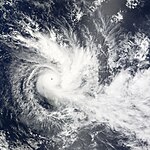2007–08 South Pacific cyclone season
| 2007–08 South Pacific cyclone season |

Season summary map
|
| Seasonal boundaries |
| First system formed |
October 17, 2007 |
| Last system dissipated |
April 19, 2008 |
| Strongest storm |
|
| Name |
Daman |
| • Maximum winds |
185 km/h (115 mph)
(10-minute sustained) |
| • Lowest pressure |
925 hPa (mbar) |
| Seasonal statistics |
| Total disturbances |
16 |
| Total depressions |
15 |
| Tropical cyclones |
4 |
| Severe tropical cyclones |
3 |
| Total fatalities |
5 direct, 3 indirect |
| Total damage |
$46 million (2008 USD) |
| Related articles |
|
|
South Pacific tropical cyclone seasons
2005–06, 2006–07, 2007–08, 2008–09, 2009–10
|
| Tropical depression (Australian scale) |
|
|
| Duration |
November 20 – November 22 |
| Peak intensity |
Winds not specified 1001 hPa (mbar) |
| Tropical depression (Australian scale) |
|
|
| Duration |
November 22 – December 2 |
| Peak intensity |
Winds not specified 999 hPa (mbar) |
| Category 4 severe tropical cyclone (Australian scale) |
| Category 3 tropical cyclone (SSHWS) |
|
|
| Duration |
December 3 – December 10 |
| Peak intensity |
185 km/h (115 mph) (10-min) 925 hPa (mbar) |
| Tropical depression (Australian scale) |
|
|
| Duration |
December 11 – December 14 |
| Peak intensity |
55 km/h (35 mph) (10-min) 1000 hPa (mbar) |
| Tropical disturbance (Australian scale) |
|
|
| Duration |
December 26 – December 28 |
| Peak intensity |
35 km/h (25 mph) (10-min) 1006 hPa (mbar) |
| Category 2 tropical cyclone (Australian scale) |
| Tropical storm (SSHWS) |
|
|
| Duration |
January 7 – January 11 |
| Peak intensity |
95 km/h (60 mph) (10-min) 980 hPa (mbar) |
| Tropical depression (Australian scale) |
|
|
| Duration |
January 9 – January 14 |
| Peak intensity |
45 km/h (30 mph) (10-min) 998 hPa (mbar) |
| Tropical depression (Australian scale) |
|
|
| Duration |
January 12 – January 13 |
| Peak intensity |
35 km/h (25 mph) (10-min) 999 hPa (mbar) |
| Category 4 severe tropical cyclone (Australian scale) |
| Category 3 tropical cyclone (SSHWS) |
|
|
| Duration |
January 15 – January 21 |
| Peak intensity |
175 km/h (110 mph) (10-min) 930 hPa (mbar) |
The 2007–08 South Pacific cyclone season was one of the least active South Pacific tropical cyclone season's on record, with only four tropical cyclones occurring within the South Pacific basin to the east of 160°E. The season officially ran from November 1, 2007 until April 30, 2008, although the first cyclone, Tropical Depression 01F, developed on October 17. The most intense tropical cyclone of the season was Severe Tropical Cyclone Daman, which reached a minimum pressure of 925 hPa (27.32 inHg) as it affected Fiji. After the season had ended, the names Daman, Funa, and Gene were retired from the tropical cyclone naming lists.
During the season, tropical cyclones were officially monitored by the Regional Specialized Meteorological Center (RSMC) in Nadi, Fiji, and the Tropical Cyclone Warning Centre (TCWC) in Wellington, New Zealand. Throughout the season the United States Navy and Air force also monitored the basin and issued unofficial warnings, through its Joint Typhoon Warning Center (JTWC). Tropical cyclones that were located between 160°E and 120°W as well as the Equator and 25°S were monitored by RSMC Nadi while any that were located to the south of 25°S between 160°E and 120°W were monitored by TCWC Wellington. During the season, RSMC Nadi and TCWC Wellington estimated sustained windspeeds over a 10-minute period and used the Australian Tropical Cyclone intensity scale, while the JTWC estimated sustained windspeeds over a 1-minute period with windspeeds compared to the Saffir-Simpson Hurricane scale.
During October 2007, both RSMC Nadi and New Zealand's National Institute of Water and Atmospheric Research (NIWA), issued forecasts for a near to below average season, due to the presence of a weak La Niña event. As a result of these conditions, neither agency predicted how many tropical cyclones would develop but noted that on average 6-8 cyclones could be expected to develop during a weak La Nina season. According to RSMC Nadi, Fiji was likely to be affected by one to two tropical cyclones, while two to three were likely to pass through Fiji's Exclusive Economic Zone. However this prediction was revised in early February, after Daman, Funa and Gene had affected the archipeligo. According to NIWA there was an average risk of a tropical cyclone coming within 550 km (340 mi) of Tuvalu, Fiji, Tonga, Tokelau, Wallis and Futuna, and Northern New Zealand, while the risks for the Solomon Islands, Vanuatu, New Caledonia, Samoa and Niue were variable and uncertain. All other islands though faced a reduced risk off being affected by a tropical cyclone.
...
Wikipedia



















